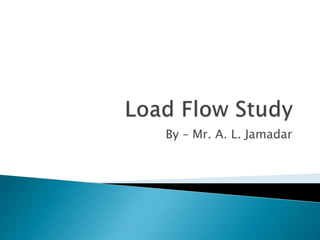Load flow study
•Download as PPTX, PDF•
2 likes•623 views
Basics of load flow study
Report
Share
Report
Share

Recommended
Recommended
More Related Content
What's hot
What's hot (20)
Line to Line & Double Line to Ground Fault On Power System

Line to Line & Double Line to Ground Fault On Power System
A Hybrid AC/DC Micro grid and Its Coordination Control

A Hybrid AC/DC Micro grid and Its Coordination Control
Power system stability and control using facts devices

Power system stability and control using facts devices
Similar to Load flow study
Similar to Load flow study (20)
Load Flow Analysis of Jamshoro Thermal Power Station (JTPS) Pakistan Using MA...

Load Flow Analysis of Jamshoro Thermal Power Station (JTPS) Pakistan Using MA...
Application of SVC on IEEE 6 Bus System for Optimization of Voltage Stability

Application of SVC on IEEE 6 Bus System for Optimization of Voltage Stability
IRJET- Load Flow Analysis of IEEE 14 Bus Systems in Matlab by using Fast Deco...

IRJET- Load Flow Analysis of IEEE 14 Bus Systems in Matlab by using Fast Deco...
International Journal of Computational Engineering Research (IJCER) 

International Journal of Computational Engineering Research (IJCER)
Voltage Stability Assessment Using the Concept of GVSM

Voltage Stability Assessment Using the Concept of GVSM
three_phase_transformers-1p protection concept.pdf

three_phase_transformers-1p protection concept.pdf
IRJET- Comparative Analysis of Load Flow Methods on Standard Bus System

IRJET- Comparative Analysis of Load Flow Methods on Standard Bus System
More from Asif Jamadar
More from Asif Jamadar (20)
Recently uploaded
9953056974 Call Girls In South Ex, Escorts (Delhi) NCR.pdf

9953056974 Call Girls In South Ex, Escorts (Delhi) NCR.pdf9953056974 Low Rate Call Girls In Saket, Delhi NCR
Recently uploaded (20)
9953056974 Call Girls In South Ex, Escorts (Delhi) NCR.pdf

9953056974 Call Girls In South Ex, Escorts (Delhi) NCR.pdf
Introduction to Machine Learning Unit-3 for II MECH

Introduction to Machine Learning Unit-3 for II MECH
Call Us ≽ 8377877756 ≼ Call Girls In Shastri Nagar (Delhi)

Call Us ≽ 8377877756 ≼ Call Girls In Shastri Nagar (Delhi)
Risk Assessment For Installation of Drainage Pipes.pdf

Risk Assessment For Installation of Drainage Pipes.pdf
Study on Air-Water & Water-Water Heat Exchange in a Finned Tube Exchanger

Study on Air-Water & Water-Water Heat Exchange in a Finned Tube Exchanger
Why does (not) Kafka need fsync: Eliminating tail latency spikes caused by fsync

Why does (not) Kafka need fsync: Eliminating tail latency spikes caused by fsync
Application of Residue Theorem to evaluate real integrations.pptx

Application of Residue Theorem to evaluate real integrations.pptx
Introduction-To-Agricultural-Surveillance-Rover.pptx

Introduction-To-Agricultural-Surveillance-Rover.pptx
CCS355 Neural Network & Deep Learning UNIT III notes and Question bank .pdf

CCS355 Neural Network & Deep Learning UNIT III notes and Question bank .pdf
Arduino_CSE ece ppt for working and principal of arduino.ppt

Arduino_CSE ece ppt for working and principal of arduino.ppt
TechTAC® CFD Report Summary: A Comparison of Two Types of Tubing Anchor Catchers

TechTAC® CFD Report Summary: A Comparison of Two Types of Tubing Anchor Catchers
Load flow study
- 1. By – Mr. A. L. Jamadar
- 2. Load flow studies or Power flow studies is the analysis of a power system in normal steady state condition. Load flow studies basically comprises of the determination of ◦ Voltage ◦ Current ◦ Active Power ◦ Reactive Power
- 3. Generation supplies demand(Load) plus losses. Bus voltage magnitude remain close to rated value. Generation operates within specified real and reactive power limits. Transmission line and transformer are not overloaded.
- 4. Designing a power system. Planning a power system. Expansion of power system. Providing guide lines for optimum operation of power system. Providing guide lines for various power system studies.
- 5. A bus is a node at which many Transmission lines, Loads Generators are connected. It is not necessary that all of them be connected to every bus. Bus is indicated by vertical line at which no. of components are connected. In load flow study two out of four quantities specified and other two quantities are to be determined by load flow equation. Depending upon that bus are classified.
- 7. A buss at which the Active power and reactive power are specified. Magnitude(V) and phase angle(δ) of the voltage will be calculated. This type of busses are most common, comprising almost 80% of all the busses in given power system.
- 8. A bus at which the magnitude(V) of the voltage and active power(P) is defined. Reactive power(Q) and Phase angle(δ) are to be determined through load flow equation. It is also known as P-V bus. This bus is always connected to generator. This type of bus is comprises about 10% of all the buses in power system.
- 9. Voltage magnitude(V) and voltage phase angle(δ) are specified and real(P) and reactive(Q) power are to be obtained. Normally there is only one bus of this type is given in power system. One generator bus is selected as the reference bus. In slack bus voltage angle and magnitude is normally considered 1+j0 p.u.
- 11. The following variables are associated with each bus: Magnitude of voltage(V) Phase angle of voltage(δ) Active power(P) Reactive power(Q) The load flow problem can solved with the help of load flow equation(Static load flow equation).
- 12. The bus admittance matrix is given by: In general the equation for bus-1 can be written as: Y11V1+Y12V2+Y13V3=I1 For bus-2 and bus-3 we can write: Y21V1+Y22V2+Y23 V3=I2 Y31V1+Y32V2+Y33 V3=I3
- 13. So Ii=Σ Yik Vk where i,k=1,2,…,n So complex power is denoted as
- 14. In polar form we can write The equation is written as: Real and reactive power expressed as: